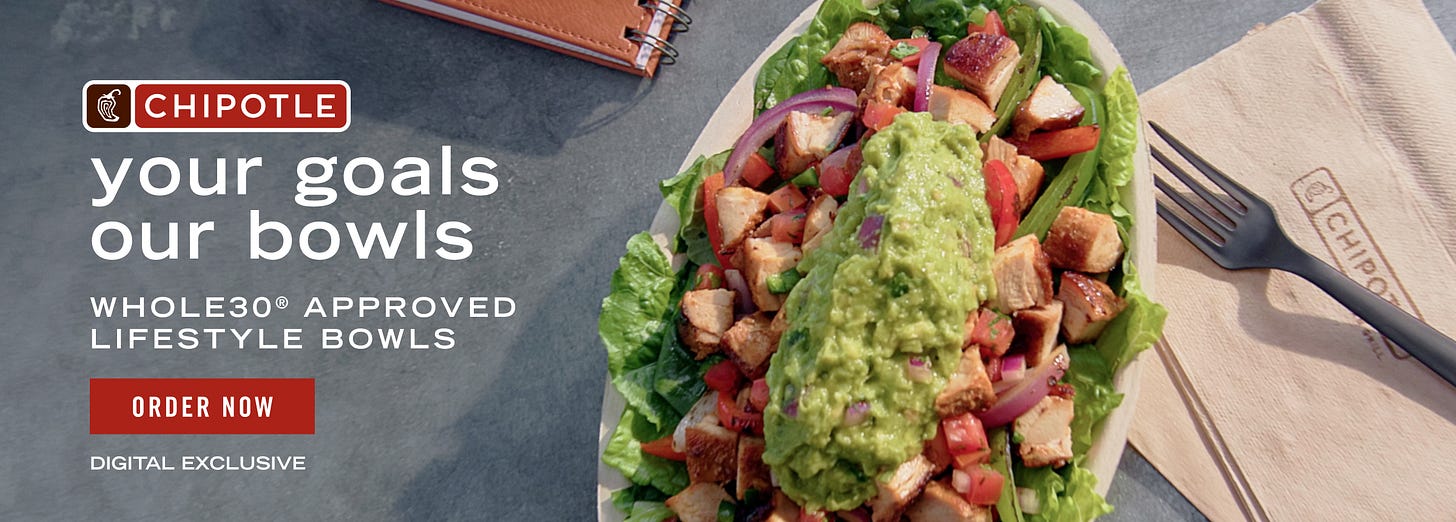What is a "high protein" meal or food?
There is no one definition, but there are some good ways to evaluate your meals to make sure you're getting enough
Today’s XOMU is sponsored by the high-protein Wholesome Bowl, available exclusively through the Chipotle app or website. Order your Wholesome Bowl for lunch or dinner today, and let Chipotle do the cooking (and dishes) for you.
I love browsing for recipes on Instagram and TikTok. The other day, I came across some “high protein” pancakes that looked promising… until I got to the ingredients. One egg—I don’t consider eggs “high protein,” and certainly not just one of them. Cottage cheese—yes, that is a high-protein food! But she was only using two tablespoons of the stuff. The rest of the ingredients didn’t include anything that would contribute more than maybe a gram of protein in total. At the end, she had three gorgeous, fluffy pancakes that combined, totaled just 11 grams of protein.
That got me thinking, “How do I decide if a meal really is high-protein, and how would I explain that to others?” Let’s get into it.
What is “high protein?”
This term has no universally-accepted definition, and to some degree is based on your context. For my mom, who eats one egg (6 grams of protein) with some berries for breakfast, an 18-gram meal might be “high protein.” For me, aiming for around 120 grams per day, 18 grams is not enough protein for a meal—I need closer to 30 grams. For a professional bodybuilder, “high protein” may mean 40-50 grams of protein per meal.
Start by deciding how much protein feels health-promoting for your context—your activity levels, muscle mass, goals, and health. Then, work backwards: How many meals and snacks do you eat in a day? How much protein would each of those meals and snacks need to have to meet your goals?
For me, if each of my three meals are around 30-35 grams each, and I add a snack with another 15-20 grams, there’s my goal. Which means a “high protein” meal for me is at minimum 25 grams of protein.
Our Registered Dietitians recommend the average 150 pound adult eat no fewer than 70 grams of protein a day. That’s a minimum! There’s a good chance you’ll need more than that to maintain or improve health and performance. That means each meal needs to include at least 25 grams of protein (if you’re eating 3 meals a day), or 20 grams of protein if you’re also eating a snack with 10+ grams.
In general, I’d say a meal needs to contain at least 25 grams of protein to be considered “high protein.” If it’s 30+ grams, I’d consider that universally “high protein” for all but the most extreme contexts (like pro bodybuilders).
How do you evaluate protein content? The Percentage Method
What if you want to look at a specific ingredient to determine if it’s “high protein,” like comparing eggs to Greek yogurt? There are a few ways to evaluate whether the food or meal is “high protein.” A popular and easy rule of thumb is the percentage method. Take the protein grams per serving and multiple it by four. Then, divide that by the total calories per serving. Generally speaking, anything at or over 40% can be considered “high protein.”
Let’s take an egg as an example. One large boiled egg contains 6g protein, and 78 calories. 6x4 = 24. 24/78 = .31. That means an egg is 31% protein—technically not a “high protein” food.
Now let’s take Fage 0% Plain Greek yogurt. One serving contains 16g protein, and 80 calories (about the same as one egg). 16x4 = 64. 64/80 = .80. That means a serving of Greek yogurt is 80% protein—making it a very “high protein” food.
Of note: This percentage can be manipulated by the amount of fat in the product. For example, Kroger brand fat-free cottage cheese has 13g protein per serving (65%); while the 4% fat version has 12g protein per serving (43%). However, I’m not always reaching for the low-fat/higher percentage version! Both are a high-protein food, and fat is a necessary component of our diets too. The 4% might taste better, work better in your system, or provide a needed boost in added fat—with virtually no difference in total protein intake.
The percentage method is an absolute way of seeing whether a food is high in protein compared to calories. More important, I use this to calculate protein based on how I actually eat. To continue the comparison, you could eat 10.6 ounces of Fage Greek Yogurt (two small containers) and get 32 grams of protein. I can easily do this as a snack if I toss in some blueberries and slivered almonds. But I’d have to eat more than 5 eggs to get the same amount of protein. I cannot eat that many eggs and still feel good. (Bleh.)
Pros of the percentage method
This method helps you identify foods that prioritize protein, helping you quickly and easily build your meal base with higher-protein ingredients. Also, when you start looking at the labels of different foods, like beans or bacon, you’ll quickly see that while these foods contain protein, they aren’t a dense source of protein. Often, if you you eat these foods in “normal” quantities, they alone won’t meet your protein goal.
To continue the example, one cup of cooked black beans contains just 8 grams of protein in 114 calories (28%). How many cups of beans do you normally eat? (Probably no more than two at a time.) A slice of Applegate’s No Sugar bacon is a bit better, containing 6 grams of protein in 70 calories (34%). Maybe you can eat 5 slices of bacon in a meal—but I sure can’t.
This can help you quantify whether a food really is “high protein,” and dispel some common myths too. (Sorry, peanut butter, but you ain’t it.)
Foods that aren’t “high protein” still play an important role in meals, adding fiber, carbs, dietary fat, and often an additional boost of protein. For example, if you add half a cup of black beans to your ground beef-based chili, you’ll add an extra 4 grams of protein. If my mom adds two slices of bacon to her breakfast, she’d get an extra 12 grams. It adds up!
Cons of the percentage method
Just because Greek yogurt is a dense source of protein doesn’t mean eating one container of Greek yogurt is enough for a meal. (Again, one 5.3 ounce container is only 16 grams—not a “high protein” meal even for the lowest targets.) You’ll still have to work these ingredients into your meal in quantities and contexts that help you meet your overall goals.
In addition, don’t discount a meal just because it doesn’t exactly meet the 40% threshold! The Wholesome Bowl at Chipotle gives you a whopping 35 grams of protein per serving—that’s “high protein” in any context! The math works out to 33%, but the rest of those calories come from 20 grams of digestion-smoothing fiber and plenty of heart-healthy monounsaturated fats from guacamole. This is a quality high-protein meal for me, and something I can happily and easily eat in one sitting.
How else do you evaluate protein content? Total protein
After I’ve determined which ingredients are “high protein” for me based on the percentage method and how I normally eat, I’ll then work on building them into a meal that meets my protein goals. When building a meal, I choose a protein-dense source as my meal base. That means I rarely eat eggs for breakfast, unless I scramble them with chicken sausage, salmon, or chicken to significantly boost the protein content. (This is part of why Ground Meat With Stuff Over Stuff works so well for me! Five ounces of ground chicken contains 27.5 grams of protein.)
Then, I’ll look for ways to boost the protein content. I add foods I know work well for me, like black beans, hummus, quinoa, a fried egg, a side of bacon or sausage, or some tofu (I love mixing pan-fried tofu with chicken, or scrambled tofu with eggs). Add some nuts and seeds, and you can significantly boost the total protein content of your meal.
By loosely calculating the amount of protein in my main protein source (usually chicken, turkey, lean ground beef, shrimp, or salmon) and roughly adding in my extras, I can easily craft a “high protein” meal of 30-35 grams of protein.
In the beginning, it may help to use a nutrition calculator, but you don’t need to track total calories (especially if that’s not healthy for your relationship with food). Just roughly track protein! Google “protein content ground chicken” and estimate your portion size. Then add in any protein boosts (like tofu, beans, or nuts) to get a rough protein total for your meal.
It’s easier with practice
I didn’t need to do the math to know that influencer’s “high protein” pancakes weren’t actually high protein by any definition. Once I saw the ingredients, I just knew. (It was especially clear when I looked at the size of those three fluffy cakes and realized even if I wanted to, I wouldn’t have room in my stomach to add chicken sausage or a few eggs to boost the protein content.)
With time and a little dedication to research, you’ll quickly learn which foods are “high protein” for your goals and needs, and how to put them together to meet your personal goals. You’ll also surely discover a few “go-to” foods or products that you know work well for you—like blending cottage cheese into just about anything, adding a scoop of collagen powder to your coffee, that plant-based protein shake that gives you 20 extra grams, or the Chipotle Wholesome Bowl, which gives you a whopping 35 grams of protein per order.
Are you specifically looking to add more protein to your meals? What are some of your “high protein” go-to foods? Drop comments and questions here! Thanks to our friends at Chipotle, today, they’re open to everyone, even free subscribers.
XO, MU
Whole30 convenience whenever and wherever you need it
For over six years, Chipotle has been your go-to for easy, delicious, high-protein Whole30 meals. This September, they’ve got your back again with a quick bite that aligns with your goals.
The Wholesome Bowl at Chipotle is a delicious, Whole30® compatible digital exclusive. Available only through the Lifestyle Bowl section of Chipotle’s app or website, it features supergreens, adobo chicken, fajita veggies, fresh tomato salsa, and a hearty scoop of guac. It’s perfect for busy work days, family takeout nights, or any time you need a ready-to-eat meal without the hassle of meal prep and cooking.
This September, whether you’re doing the Whole30 or embracing your food freedom, Chipotle is here to support you with a fresh, delicious meal. Head to the Chipotle app or website and order your Wholesome Bowl for lunch or dinner today! Enjoy the convenience, and let Chipotle handle the rest.





High-protein meals are key to staying full and energized, especially during busy holidays like the 4th of July. If you're wondering Is Chipotle Open On 4th Of July Independence Day, you're in luckmost locations are! It's a great spot to grab a protein-packed burrito and keep your celebrations going strong. Just be sure to check local hours before heading out. https://allchipotlemenu.com/hours/is-chipotle-open-on-4th-of-july/
Thank you! What a comprehensive post. Excited to share with our readers.